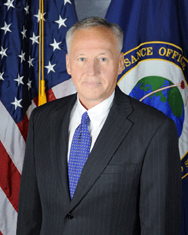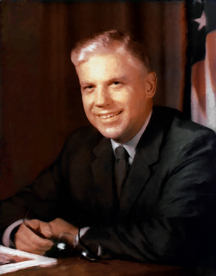 W
WEdward "Pete" Cleveland Aldridge Jr. is an aerospace engineer and former government official in the U.S. Defense Department. He was also selected as a payload specialist for the Space Shuttle mission STS-62-A, scheduled to launch in July 1986. The mission was canceled after the Space Shuttle Challenger disaster in January 1986 and Aldridge never flew.
 W
WBruce Allen Carlson, was the 16th Director of the National Reconnaissance Office. He is a former four-star general in the United States Air Force and served as the sixth Commander, Air Force Materiel Command, Wright-Patterson Air Force Base, Ohio. The command conducts research, development, test and evaluation, and provides acquisition management services and logistics support necessary to keep Air Force weapon systems ready for war. After over 37 years of service, he retired from the Air Force on January 1, 2009. Carlson served as a general authority and a member of the Second Quorum of the Seventy of The Church of Jesus Christ of Latter-day Saints from April 2009 to October 2015.
 W
WJoseph Vincent Charyk was widely credited as the founder of the geosynchronous communications satellite industry. He was born in Canmore, Alberta in a Ukrainian family. Early in his career, Charyk consolidated the Central Intelligence Agency, United States Air Force, and United States Navy space programs into the National Reconnaissance Office (NRO). He brought the first United States imagery satellite, CORONA, into operation and demonstrated signals intelligence technology from space. During his tenure, the NRO operated the U-2 reconnaissance aircraft and managed development of the A-12.
 W
WMartin C. Faga was the tenth Director of the National Reconnaissance Office (DNRO).
 W
WAlexander Henry Flax was the Chief Scientist of the U.S. Air Force (USAF) from 1959 to 1961, Assistant Secretary of the Air Force for Research and Development from 1963 to 1969, and the third Director of the National Reconnaissance Office (NRO) from 1965 to 1969. He was the director at a time when the second generation of imaging systems became operational and began to play a major role in United States intelligence during the Cold War. He oversaw major growth in NRO funding and personnel, the development of signals intelligence collectors from space, and the development of electro-optical imaging for US reconnaissance satellites.
 W
WKeith R. Hall was the 12th director of the National Reconnaissance Office(NRO).
 W
WJeffrey K. Harris is an American aerospace executive who served as 11th director of the National Reconnaissance Office from 1994 to 1996. He is currently the chairman of the board of the United States Geospatial Intelligence Foundation.
 W
WRobert Jay Hermann was the eighth Director of the National Reconnaissance Office.
 W
WDonald MacLean Kerr, Jr. served as the Principal Deputy Director of National Intelligence from 2007 to 2009. He was confirmed by the U.S. Senate on Thursday, October 4, 2007. In March 2009, he received the National Intelligence Distinguished Service Medal.
 W
WScott F. Large is an American intelligence officer and analyst who served as the fifteenth Director of the National Reconnaissance Office from 2007 to 2009. He previously served as the Principal Deputy Director of the National Reconnaissance Office from April to October 2007, and as the Central Intelligence Agency's Associate Deputy Director for Science and Technology.
 W
WJohn Luther McLucas was United States Secretary of the Air Force from 1973 to 1975, becoming Secretary of the Air Force on July 19, 1973. He had been Acting Secretary of the Air Force since May 15, 1973, and Under Secretary of the Air Force since March 1969. Prior to his appointment as Under Secretary, he was president and chief executive officer of MITRE Corporation, of Bedford, Massachusetts, and McLean, Virginia.
 W
WBrockway McMillan was an American government official and scientist, who served as the eighth Under Secretary of the Air Force and the second Director of the National Reconnaissance Office.
 W
WJames W. Plummer was an engineer who served as the fifth Director of the National Reconnaissance Office. Plummer was the first Director NRO to come from private industry. He previously served as the Lockheed Corporation program manager for the CORONA and LANYARD imaging systems. Plummer focused on developing the second generation of U.S. satellites – the electro-optical systems. He earned a master's degree in electrical engineering from the University of Maryland in 1953. In 2005 he received the Charles Stark Draper Prize for his contributions to the CORONA project. He died at Medford, Oregon in 2013. He was 92.
 W
WBetty Jean Sapp is the former Director of the National Reconnaissance Office (DNRO). She served as a United States Air Force Officer and employee of the Central Intelligence Agency. She was the first female Director of the NRO.
 W
WDr. Christopher J. Scolese is director of the National Reconnaissance Office. He was appointed the 19th Director of the National Reconnaissance Office (DNRO) on August 1, 2019. Scolese was sworn into office on August 5, 2019.
 W
WPeter B. Teets was the thirteenth Director of the National Reconnaissance Office and the Under Secretary of the Air Force.